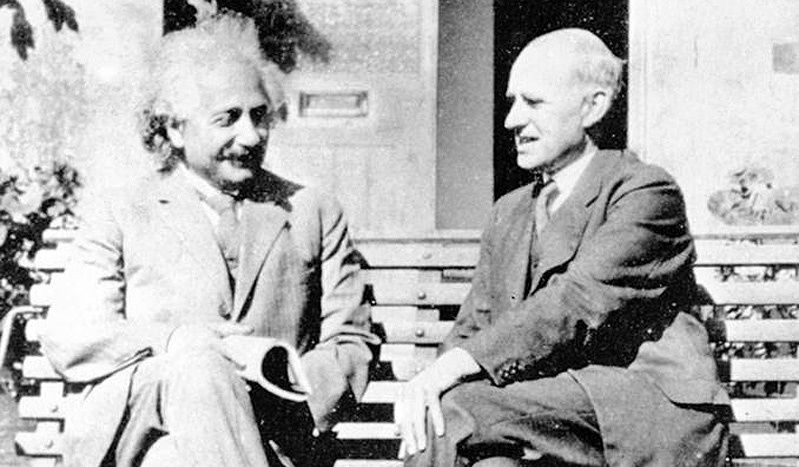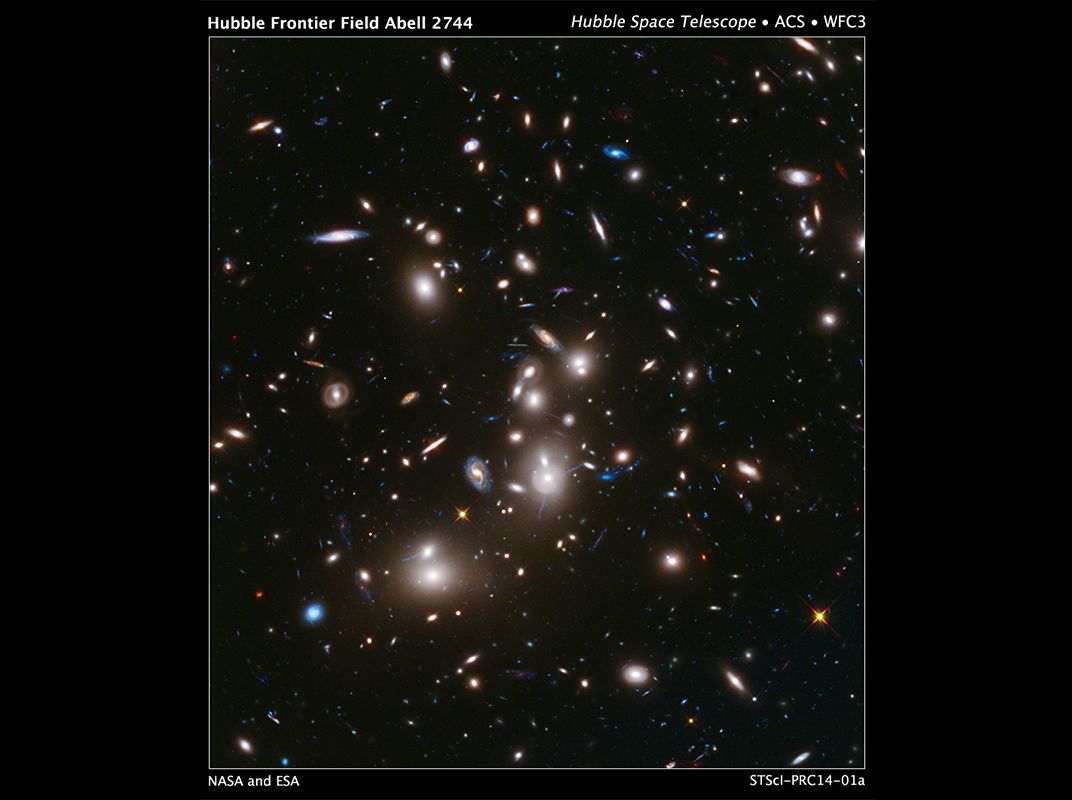Long After Einstein, Cosmic Lensing Reaches Its Full Potential
How Hubble is taking advantage of Einstein’s theories to study the most distant galaxies
/https://tf-cmsv2-smithsonianmag-media.s3.amazonaws.com/filer/2f/a3/2fa3d258-0773-47dd-9bb0-a653c517b50e/abell370_hst.jpg)
A hundred years ago, Albert Einstein introduced a radical new way of thinking about the force of gravity. His general theory of relativity posited that space is not an empty arena in which the events of the universe play out—but an active participant in those events.
According to general relativity, anything that has mass—a star, a planet, an otter—distorts the space around it, causing it to curve. Matter curves space, and that curvature tells other matter how to move. We humans are ill equipped to imagine a curved three-dimensional space, so here’s a two-dimensional analogy: if a heavy ball is placed upon a trampoline, the surface of the trampoline will bend. If you then roll marbles across the surface of the trampoline, their paths will be curved. It's an imperfect analogy, but conveys the general idea. This principle is why Earth follows a curved path around the Sun and the Moon follows a curved path around Earth.
A key feature of general relativity is that the curvature of space affects the path of light as well as matter. This effect is known as “gravitational lensing.” This turns out to be different to the way light behaves under Newtonian gravity, so an immediate use of gravitational lensing is to test whether general relativity is real. It also turns out to be extremely useful for studying the most distant corners of the universe, as it causes the images of faraway galaxies to be magnified.
How does gravitational lensing work? If light traveling towards us from some distant star passes by another massive object—say, another star or galaxy—that light gets deflected, and its path is altered. When that light reaches Earth, it appears to be coming from a different direction than its original path. We see the star as being in a different position on the sky than where it’s actually located. This apparent movement of the background star is exactly double what you would see in Newtonian gravity; hence, it provides a simple way to test Einstein’s theory.
To measure how much the image of a star has moved, though, you have to be able to observe it both before and after its light is deflected by the intervening mass. We don't usually have the option of getting far enough away from the Earth to see distant stars from two different angles, but we can take advantage of the fact that we are moving around the sun.
If we observe a star in the opposite part of the sky from the sun, we see its "true" position. Six months later, the star will be in the same part of the sky as the sun, and we can then measure how much the star's light is deflected by the mass of the sun. We can’t usually observe stars when they are close to the sun because it’s daytime when the sun is up. But under certain circumstances, we can. There is one time when the sun is up, but sunlight is blocked: a total solar eclipse.
In May 1919, astronomers got to glimpse a solar eclipse that was visible from parts of both Africa and South America. To maximize the chances of observing the eclipse successfully, two teams were dispatched to observe it: one to Brazil and one, led by Sir Arthur Eddington, to the island of Principe off the coast of West Africa. Despite partial cloud cover, Eddington’s team was successful. The deflection of the light they measured from the stars in the Hyades cluster matched Einstein's theory perfectly.

This discovery was momentous. "LIGHTS ALL ASKEW IN THE HEAVENS. EINSTEIN THEORY TRIUMPHS," proclaimed the New York Times. (It added: “Men of Science More or Less Agog Over Results of Eclipse Observations.”) The confirmation provided a moment of unity in a world torn apart by war; as noted by Physicist J.P. McEvoy in his 1999 book Eclipse, "a new theory of the universe, the brainchild of a German Jew working in Berlin, was confirmed by an English Quaker on a small African island."
It wasn’t until 1936 that a Swiss astronomer named Fritz Zwicky realized the potential of gravitational lensing as a tool to study the universe beyond our stellar neighborhood. When calculating the masses of clusters of galaxies—known at the time as extragalactic nebulae—Zwicky noted that there was a good chance more distant galaxies located behind them would have their light deflected as it passed these clusters. In 1937, he wrote that this effect "would enable us to see nebulae at distances greater than those ordinarily reached by even the greatest telescopes."
The key to this concept is a feature of gravitational lensing that makes it incredibly useful: Light that would otherwise be directed away from us is turned in our direction, meaning that we see more light from lensed sources than we ordinarily would. In other words, distant galaxies that happen to lie behind massive objects are magnified. And since clusters of galaxies are the most massive structures in the universe, they are the best magnifying glasses nature has to offer.
For almost 50 years, Zwicky's suggestion received little attention. The potential lensed galaxies were, after all, far too faint to be seen. That changed in the 1980s, when the development of the first digital imaging devices replaced photographic plates and dramatically increased the sensitivity of telescopes to faint sources.
In 1986, a dramatic extended arc was discovered in the galaxy cluster Abell 370. The long, red arc in this image turned out to be twice as far away as the cluster itself: it's a background galaxy— a spiral much like the Milky Way—whose light has been distorted by the mass of the cluster, stretching it into this enormous arc. A decade later, another lensed galaxy broke the record for the most distant object known, the first time since the 1960s that a regular galaxy—not a quasar, the brightest objects in the universe—had held that record.

In 2009, the launch of the Hubble Space Telescope (HST) provided the most sensitive images ever obtained of the distant universe, and its final servicing mission added a new extremely sensitive near-infrared camera. Currently underway with Hubble is a new program that promises to push the limits of our gaze into the universe even further: the Hubble Frontier Fields program.
The idea behind this program is to make incredibly deep observations that reveal the faintest, most distant galaxies—but strategically aimed at clusters of galaxies so as to benefit from the magnifying effect of gravitational lensing. The program will cover six massive galaxy clusters in total, five of which have been completed to date. The lead scientist on the Frontier Fields project, Jen Lotz, described it as "the deepest view of the universe ever taken."
"The Frontier Fields is an experiment," says Matt Mountain, president of the Association of Universities for Research in Astronomy (AURA) and former director of the Space Telescope Science Institute that operates Hubble. The experiment’s core question: "Can we use Hubble's exquisite image quality and Einstein's theory of General Relativity to search for the first galaxies?"
Preliminary analysis of the first Frontier Fields has already begun to yield a wealth of insight into the early universe. Far behind the first cluster, Abell 2744, we have found magnified images of a group of galaxies in the early universe – just a few hundred million years after the Big Bang—that may be in the process of forming a cluster of their own.
Careful study of the Frontier Fields images reveals galaxies magnified 50 times or more by gravitational lensing. These are some of the faintest galaxies ever seen in the early universe. The smallest of these will become something like the Fornax dwarf, a tiny galaxy that orbits the Milky Way and is about a thousandth its mass. Although that’s tiny by galaxy standards, we're learning from the Frontier Fields that there were a huge number of small galaxies in the early universe. So many, in fact, that together they may have been responsible for most of the energy in the first billion years of the universe.
The limit of how far into the past we can see is set by the capabilities of the Hubble Space Telescope. The very first galaxies have their light shifted so far into the infrared by the expansion of space that Hubble cannot see them. This will all change in 2018 when Hubble's successor, the James Webb Space Telescope, launches in 2018. With a larger mirror and more sensitive cameras that can see further into the infrared, Webb will allow us to peer even further into the past, and to view even fainter galaxies. By pointing Webb at galaxy clusters and using gravitational lensing to our advantage, we can push those limits further still.
In just a few years, we may well be looking at the very first galaxies ever to have formed.